Get free scan and check if your device is infected.
Remove it nowTo use full-featured product, you have to purchase a license for Combo Cleaner. Seven days free trial available. Combo Cleaner is owned and operated by RCS LT, the parent company of PCRisk.com.
What is USAA email scam?
Commonly, phishing emails such as this example are used to trick recipients into providing sensitive information such as credit card details, login credentials (emails, usernames, passwords) or other details, which could be misused for malicious purposes.
Generally, cyber criminals attempt to trick recipients into proving this information by disguising their emails as important and official and/or by exploiting names of legitimate companies. In this particular case, an email is disguised as a message from USAA, a legitimate financial services company.
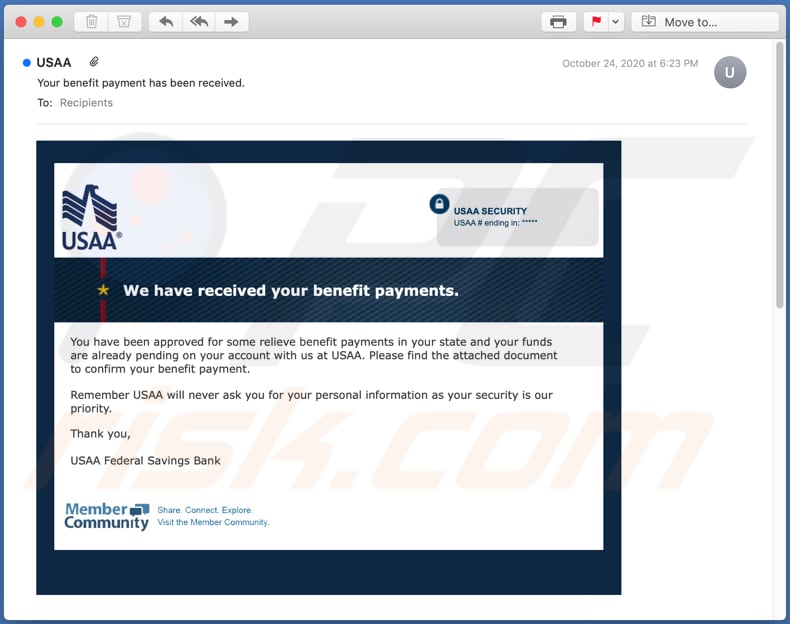
USAA email scam overview
There are at least two variants of this phishing email: one attempts to trick users into opening a potentially malicious, phishing website directly through a link, whilst another has a PDF document attached to it containing a link to a phishing site. These variants also differ in that one asks to verify a mobile telephone number, whilst another asks to confirm a benefit payment.
In fact, the main purpose of both variants is identical: to trick recipients into providing sensitive information on a phishing website.
As mentioned, cyber criminals behind these emails attempt to obtain sensitive information such as usernames, passwords, and credit card details so they can misuse the details to steal accounts and identities, make fraudulent purchases and transactions, and for other malicious purposes. These malicious emails should be ignored.
| Name | USAA Email Scam |
| Threat Type | Phishing, Scam, Social Engineering, Fraud. |
| Fake Claim | Mobile number in the USAA account needs to be verified/benefit payment has been received. |
| Disguise | Message from the USAA financial services company. |
| Symptoms | Unauthorized online purchases, changed online account passwords, identity theft, illegal access of the computer. |
| Distribution methods | Deceptive emails, rogue online pop-up ads, search engine poisoning techniques, misspelled domains. |
| Damage | Loss of sensitive private information, monetary loss, identity theft. |
| Malware Removal (Windows) |
To eliminate possible malware infections, scan your computer with legitimate antivirus software. Our security researchers recommend using Combo Cleaner. Download Combo CleanerTo use full-featured product, you have to purchase a license for Combo Cleaner. 7 days free trial available. Combo Cleaner is owned and operated by RCS LT, the parent company of PCRisk.com. |
Spam campaign examples
Some examples of other similar scams include "Your Microsoft Subscription Has Been Expired Email Scam", "You've Been Hacked! Email Scam", and "PASSWORD EXPIRATION NOTICE Email Scam".
Typically, recipients who trust these emails become victims of identity theft, suffer monetary loss, lose access to personal accounts and encounter other serious problems. Note that emails can be used to trick recipients into providing sensitive information, making money transactions, and also into installing various malware (e.g., ransomware, Trojans).
How do spam campaigns infect computers?
Typically, cyber criminals behind malspam campaigns send emails with a file attached to them or a download link to the malicious file. Their main goal is to trick recipients into opening/executing a the rogue file, which then installs malicious software.
Some examples of files that cyber criminals send via email are Microsoft Office and PDF documents, executables (.exe), JavaScript, and archives (ZIP, RAR). Note that malicious documents that are opened with Microsoft Office 2010 or newer versions install malicious software only if users enable macros commands (enable editing/content).
These versions include "Protected View" mode, which does not allow opened malicious documents to install malware automatically. Older versions do not include this feature and install malicious software without asking permission.
How to avoid installation of malware?
To avoid infecting the system with malware spread through spam mail, you are strongly advised not to open suspicious or irrelevant emails, especially those with any attachments or links present in them. Use official and verified download channels.
Additionally, all programs must be activated and updated with tools/functions provided by legitimate developers, since illegal activation tools ("cracks") and third party updaters commonly proliferate malicious software. To ensure device integrity and user safety, it is paramount to have reputable anti-virus/anti-spyware installed and kept updated.
Furthermore, use these programs to run regular system scans and to remove detected/potential threats. If you've already opened malicious attachments, we recommend running a scan with Combo Cleaner Antivirus for Windows to automatically eliminate infiltrated malware.
Text presented in the USAA phishing email with a file attached to it:
Subject: Your benefit payment has been received.
We have received your benefit payments.You have been approved for some relieve benefit payments in your state and your funds are already pending on your account with us at USAA. Please find the attached document to confirm your benefit payment.
Remember USAA will never ask you for your personal information as your security is our priority.
Thank you,USAA Federal Savings Bank
Screenshot of the PDF document attached to this variant:
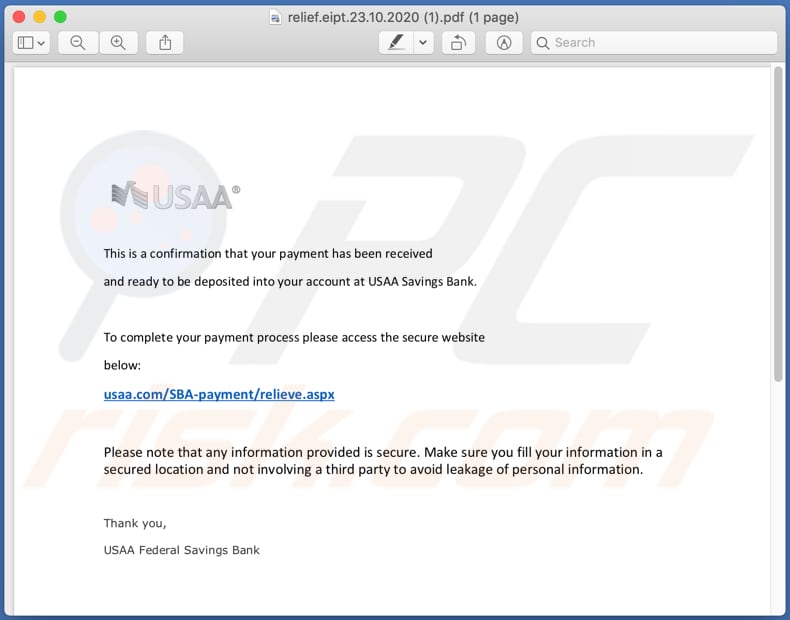
Text in this PDF document:
This is a confirmation that your payment has been received
and ready to be deposited into your account at USAA Savings Bank.
To complete your payment process please access the secure website below:
usaa.com/SBA-payment/relieve[.]aspx
Please note that any information provided is secure. Make sure you fill your information in a secured location and not involving a third party to avoid leakage of personal information.
Thank you,
USAA Federal Savings Bank
Screenshot of the second variant of this phishing email:
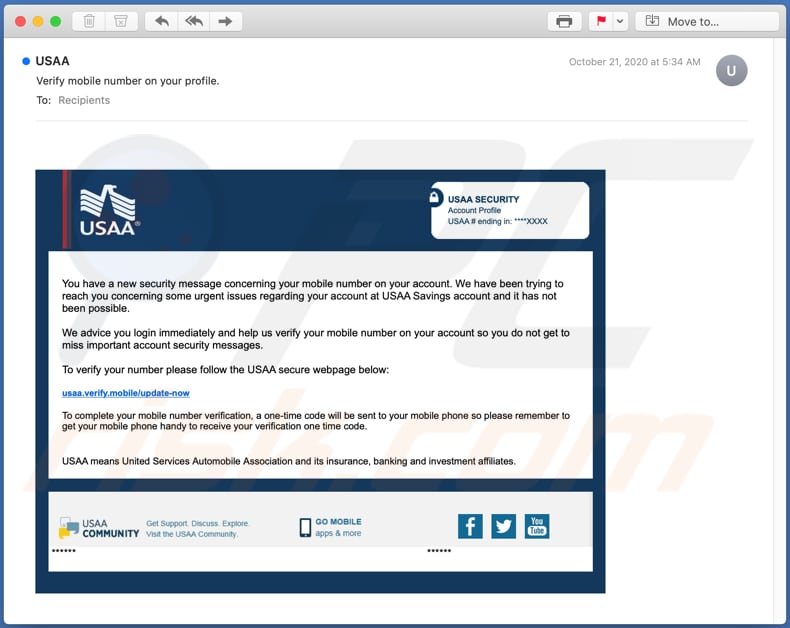
Text in this variant:
Subject: Verify mobile number on your profile.
USAA SECURITY
Account Profile
USAA # ending in: ****XXXXYou have a new security message concerning your mobile number on your account. We have been trying to reach you concerning some urgent issues regarding your account at USAA Savings account and it has not been possible.
We advice you login immediately and help us verify your mobile number on your account so you do not get to miss important account security messages.
To verify your number please follow the USAA secure webpage below:
usaa.verify[.]mobile/update-now
To complete your mobile number verification, a one-time code will be sent to your mobile phone so please remember to get your mobile phone handy to receive your verification one time code.
USAA means United Services Automobile Association and its insurance, banking and investment affiliates.
USAA Community Go Mobile Facebook Twitter You Tube
Yet another variant of this scam email:
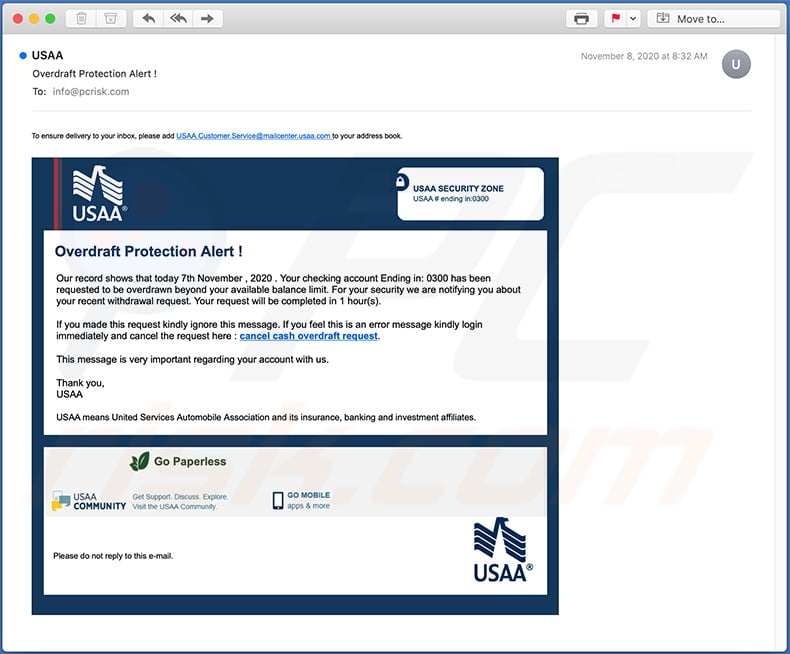
Text presented within:
Subject: Overdraft Protection Alert !
To ensure delivery to your inbox, please add USAA.Customer.Service@mailcenter.usaa.com to your address book.
USAA Logo
USAA SECURITY ZONE
USAA # ending in:0300Overdraft Protection Alert !
Our record shows that today 7th November , 2020 . Your checking account Ending in: 0300 has been requested to be overdrawn beyond your available balance limit. For your security we are notifying you about your recent withdrawal request. Your request will be completed in 1 hour(s).
If you made this request kindly ignore this message. If you feel this is an error message kindly login immediately and cancel the request here : cancel cash overdraft request.
This message is very important regarding your account with us.
Thank you,
USAA
USAA means United Services Automobile Association and its insurance, banking and investment affiliates.
a
Go Paperless Go PaperlessUSAA Community Go Mobile
Please do not reply to this e-mail.
Yet another variant of USAA-themed spam email promoting a phishing website:
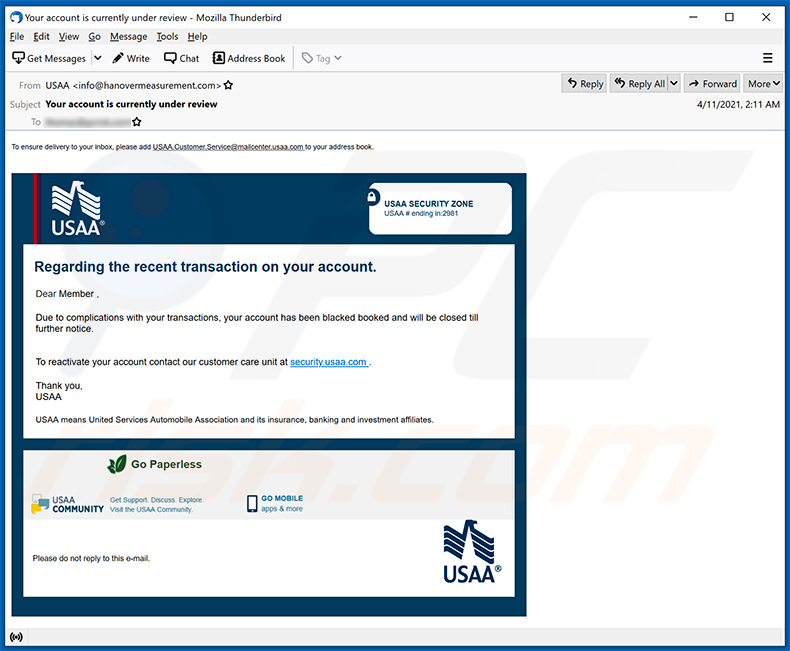
Text presented within:
Subject: Your account is currently under review
To ensure delivery to your inbox, please add USAA.Customer.Service@mailcenter.usaa.com to your address book.
USAA SECURITY ZONE
USAA # ending in:2981Regarding the recent transaction on your account.
Dear Member ,
Due to complications with your transactions, your account has been blacked booked and will be closed till further notice.
To reactivate your account contact our customer care unit at security.usaa.com .
Thank you,
USAA
USAA means United Services Automobile Association and its insurance, banking and investment affiliates.
USAA Community Go Mobile
Please do not reply to this e-mail.
Screenshot of the promoted phishing website (навчалочка[.]com):
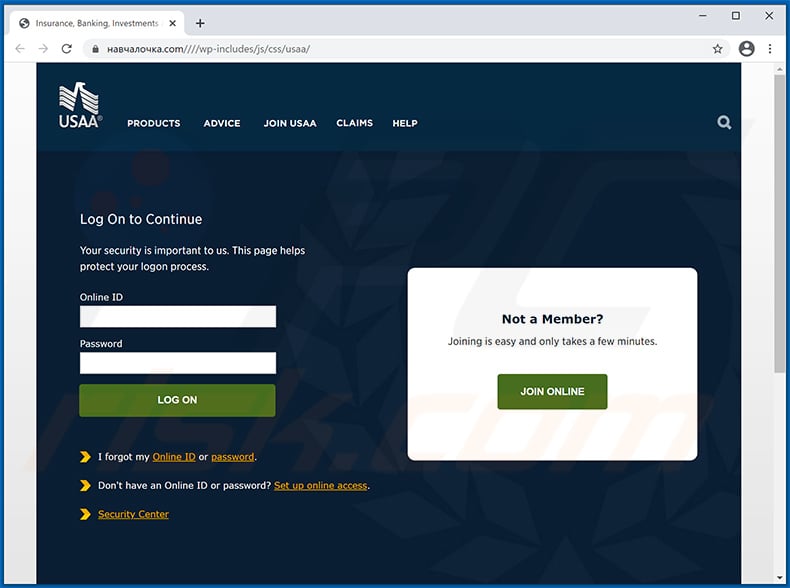
Examples of other USAA-themed spam emails promoting an identical website.
Example 1:
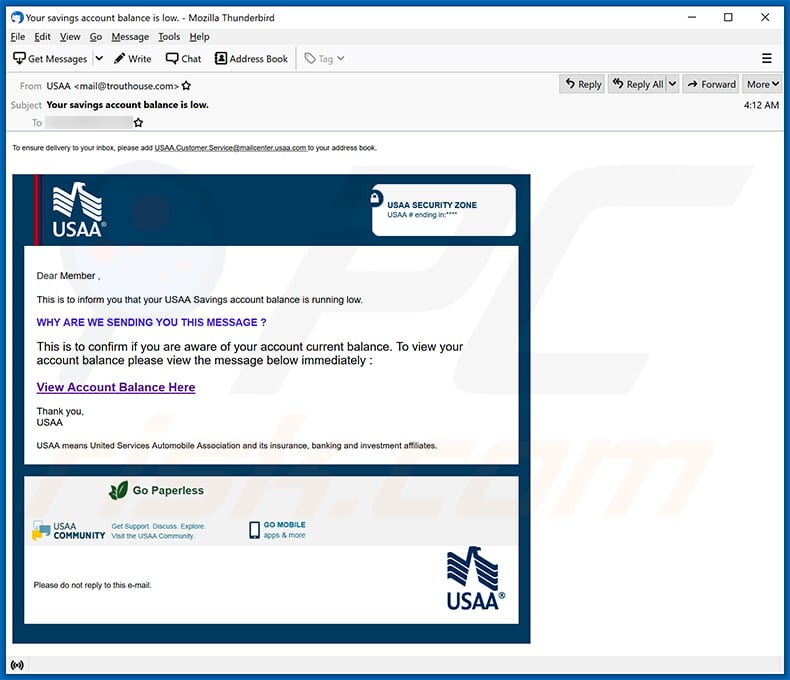
Text presented within:
Subject: Your savings account balance is low.
To ensure delivery to your inbox, please add USAA.Customer.Service@mailcenter.usaa.com to your address book.
USAA SECURITY ZONE
USAA # ending in:****
Dear Member ,
This is to inform you that your USAA Savings account balance is running low.WHY ARE WE SENDING YOU THIS MESSAGE ?
This is to confirm if you are aware of your account current balance. To view your account balance please view the message below immediately :
View Account Balance Here
Thank you,
USAA
USAA means United Services Automobile Association and its insurance, banking and investment affiliates.
Go Paperless Go PaperlessUSAA Community Go Mobile
Please do not reply to this e-mail.
Example 2:
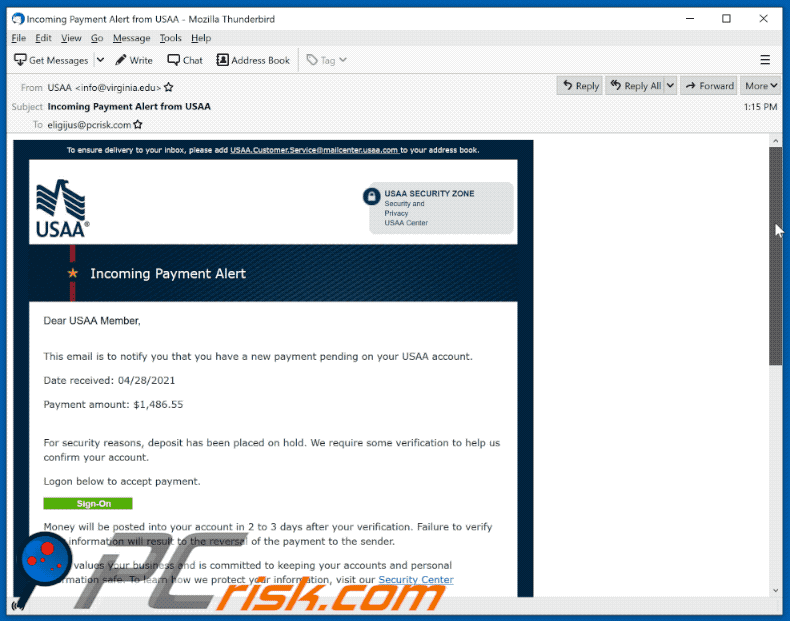
Text presented within:
Subject: Incoming Payment Alert from USAA
To ensure delivery to your inbox, please add USAA.Customer.Service@mailcenter.usaa.com to your address book.
USAA SECURITY ZONE
Security and
Privacy
USAA CenterIncoming Payment Alert
Dear USAA Member,This email is to notify you that you have a new payment pending on your USAA account.
Date received: 04/28/2021
Payment amount: $1,486.55
For security reasons, deposit has been placed on hold. We require some verification to help us confirm your account.
Logon below to accept payment.
Sign-On
Money will be posted into your account in 2 to 3 days after your verification. Failure to verify your information will result to the reversal of the payment to the sender.
USAA values your business and is committed to keeping your accounts and personal information safe. To learn how we protect your information, visit our Security Center
Thank you,
USAAUSAA means United Services Automobile Association and its insurance, banking and investment affiliates.
Member Community Go Mobile Facebook Twitter You Tube More
Please do not reply to this e-mail. To contact USAA, visit our secure contact page.
Privacy Promise
USAA, 9800 Fredericksburg Road, San Antonio, Texas 78288
We know what it means to serve ®
Insurance Banking Investments Retirement Advice
Yet another example of USAA-themed spam email promoting a phishing site:
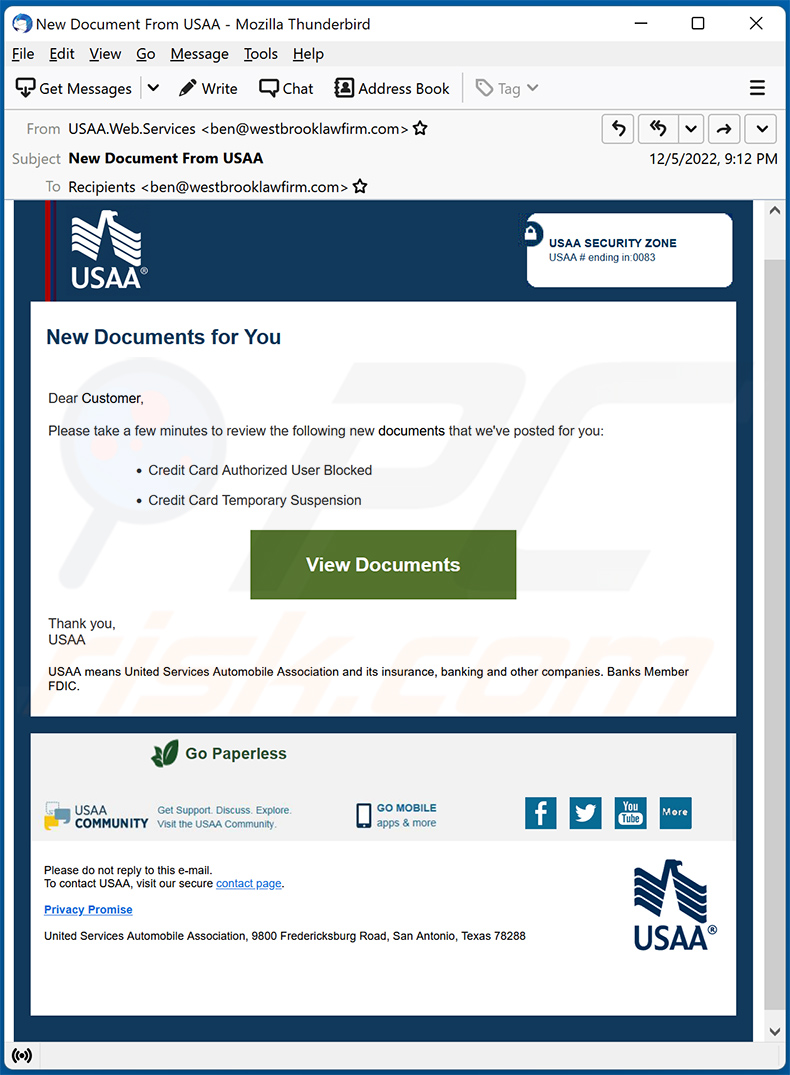
Text presented within:
Subject: New Document From USAA
USAA
USAA SECURITY ZONE
USAA # ending in:0083New Documents for You
Dear Customer,
Please take a few minutes to review the following new documents that we've posted for you:
Credit Card Authorized User Blocked
Credit Card Temporary Suspension
View DocumentsThank you,
USAA
USAA means United Services Automobile Association and its insurance, banking and other companies. Banks Member FDIC.
Go Paperless Go Paperless
USAA Community Go Mobile FacebookTwitterYou TubeMore
Please do not reply to this e-mail.
To contact USAA, visit our secure contact page.Privacy Promise
United Services Automobile Association, 9800 Fredericksburg Road, San Antonio, Texas 78288
Screenshot of the promoted phishing site:
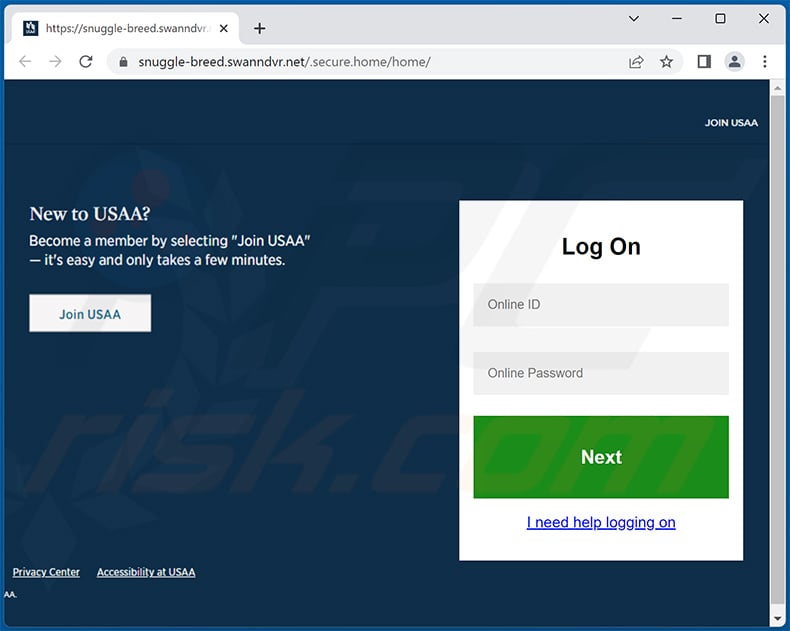
Another example of an email from "USAA" spam campaign:
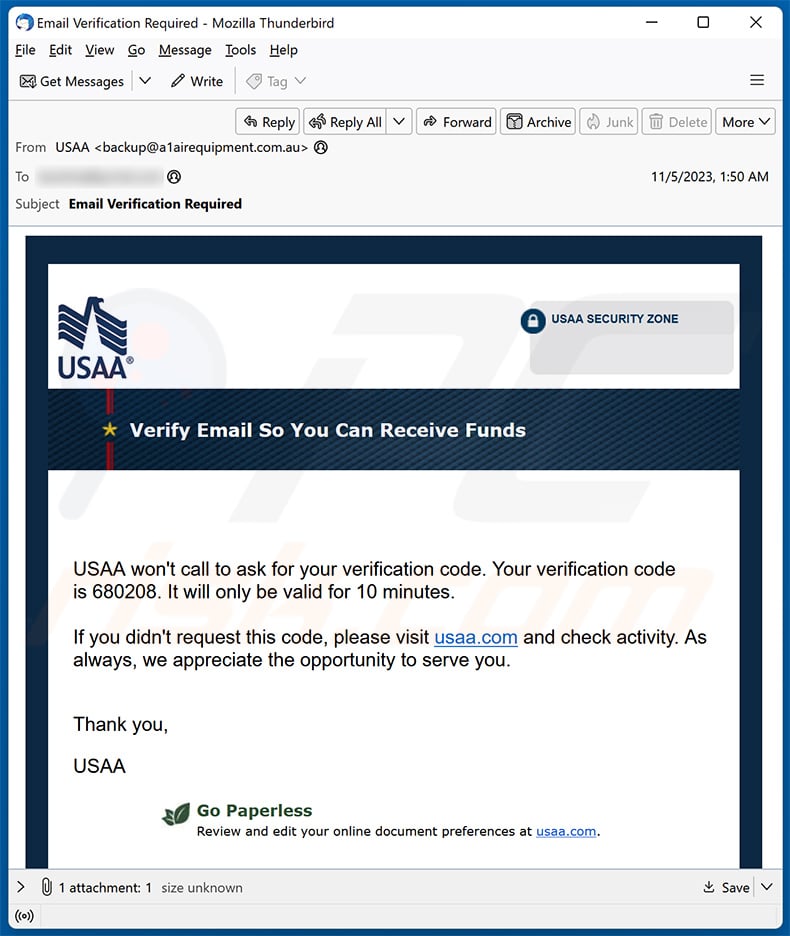
Text presented within:
Subject: Email Verification Required
USAA SECURITY ZONE
Verify Email So You Can Receive Funds
USAA won't call to ask for your verification code. Your verification code is 680208. It will only be valid for 10 minutes.If you didn't request this code, please visit usaa.com and check activity. As always, we appreciate the opportunity to serve you.
Thank you,
USAA
Instant automatic malware removal:
Manual threat removal might be a lengthy and complicated process that requires advanced IT skills. Combo Cleaner is a professional automatic malware removal tool that is recommended to get rid of malware. Download it by clicking the button below:
DOWNLOAD Combo CleanerBy downloading any software listed on this website you agree to our Privacy Policy and Terms of Use. To use full-featured product, you have to purchase a license for Combo Cleaner. 7 days free trial available. Combo Cleaner is owned and operated by RCS LT, the parent company of PCRisk.com.
Quick menu:
- What is USAA spam?
- Types of malicious emails.
- How to spot a malicious email?
- What to do if you fell for an email scam?
Types of malicious emails:
![]() Phishing Emails
Phishing Emails
Most commonly, cybercriminals use deceptive emails to trick Internet users into giving away their sensitive private information, for example, login information for various online services, email accounts, or online banking information.
Such attacks are called phishing. In a phishing attack, cybercriminals usually send an email message with some popular service logo (for example, Microsoft, DHL, Amazon, Netflix), create urgency (wrong shipping address, expired password, etc.), and place a link which they hope their potential victims will click on.
After clicking the link presented in such email message, victims are redirected to a fake website that looks identical or extremely similar to the original one. Victims are then asked to enter their password, credit card details, or some other information that gets stolen by cybercriminals.
![]() Emails with Malicious Attachments
Emails with Malicious Attachments
Another popular attack vector is email spam with malicious attachments that infect users' computers with malware. Malicious attachments usually carry trojans that are capable of stealing passwords, banking information, and other sensitive information.
In such attacks, cybercriminals' main goal is to trick their potential victims into opening an infected email attachment. To achieve this goal, email messages usually talk about recently received invoices, faxes, or voice messages.
If a potential victim falls for the lure and opens the attachment, their computers get infected, and cybercriminals can collect a lot of sensitive information.
While it's a more complicated method to steal personal information (spam filters and antivirus programs usually detect such attempts), if successful, cybercriminals can get a much wider array of data and can collect information for a long period of time.
![]() Sextortion Emails
Sextortion Emails
This is a type of phishing. In this case, users receive an email claiming that a cybercriminal could access the webcam of the potential victim and has a video recording of one's masturbation.
To get rid of the video, victims are asked to pay a ransom (usually using Bitcoin or another cryptocurrency). Nevertheless, all of these claims are false - users who receive such emails should ignore and delete them.
How to spot a malicious email?
While cyber criminals try to make their lure emails look trustworthy, here are some things that you should look for when trying to spot a phishing email:
- Check the sender's ("from") email address: Hover your mouse over the "from" address and check if it's legitimate. For example, if you received an email from Microsoft, be sure to check if the email address is @microsoft.com and not something suspicious like @m1crosoft.com, @microsfot.com, @account-security-noreply.com, etc.
- Check for generic greetings: If the greeting in the email is "Dear user", "Dear @youremail.com", "Dear valued customer", this should raise suspiciousness. Most commonly, companies call you by your name. Lack of this information could signal a phishing attempt.
- Check the links in the email: Hover your mouse over the link presented in the email, if the link that appears seems suspicious, don't click it. For example, if you received an email from Microsoft and the link in the email shows that it will go to firebasestorage.googleapis.com/v0... you shouldn't trust it. It's best not to click any links in the emails but to visit the company website that sent you the email in the first place.
- Don't blindly trust email attachments: Most commonly, legitimate companies will ask you to log in to their website and to view any documents there; if you received an email with an attachment, it's a good idea to scan it with an antivirus application. Infected email attachments are a common attack vector used by cybercriminals.
To minimise the risk of opening phishing and malicious emails we recommend using Combo Cleaner Antivirus for Windows.
Example of a spam email:

What to do if you fell for an email scam?
- If you clicked on a link in a phishing email and entered your password - be sure to change your password as soon as possible. Usually, cybercriminals collect stolen credentials and then sell them to other groups that use them for malicious purposes. If you change your password in a timely manner, there's a chance that criminals won't have enough time to do any damage.
- If you entered your credit card information - contact your bank as soon as possible and explain the situation. There's a good chance that you will need to cancel your compromised credit card and get a new one.
- If you see any signs of identity theft - you should immediately contact the Federal Trade Commission. This institution will collect information about your situation and create a personal recovery plan.
- If you opened a malicious attachment - your computer is probably infected, you should scan it with a reputable antivirus application. For this purpose, we recommend using Combo Cleaner Antivirus for Windows.
- Help other Internet users - report phishing emails to Anti-Phishing Working Group, FBI’s Internet Crime Complaint Center, National Fraud Information Center and U.S. Department of Justice.
Frequently Asked Questions (FAQ)
Why did I receive this email?
Spam emails are not personal. These letters are distributed in mass-scale campaigns – hence, thousands of users receive identical messages.
I have provided my personal information when tricked by this spam email, what should I do?
If you have provided account log-in credentials – immediately change the passwords of all potentially exposed accounts and contact their official support. And if you've disclosed other private data (e.g., ID card details, credit card numbers, etc.) – inform the appropriate authorities without delay.
I have read a spam email but didn't open the attachment, is my computer infected?
No, just opening/reading an email will not result in a system infection. Devices are infected when the attachments/links found in malicious spam mail are opened/clicked.
I have downloaded and opened a file attached to a spam email, is my computer infected?
Whether your device was infected may depend on the opened file's format. If it was an executable (.exe, .run, etc.) – most likely, yes – the system was infected. However, documents (.doc, .xls, .pdf, etc.) might need additional user interaction (e.g., enabling macro commands) to start downloading/installing malware.
Will Combo Cleaner remove malware infections present in email attachments?
Yes, Combo Cleaner is capable of detecting and eliminating practically all known malware infections. It must be emphasized that performing a complete system scan is crucial since high-end malicious software typically hides deep within systems.
Share:

Tomas Meskauskas
Expert security researcher, professional malware analyst
I am passionate about computer security and technology. I have an experience of over 10 years working in various companies related to computer technical issue solving and Internet security. I have been working as an author and editor for pcrisk.com since 2010. Follow me on Twitter and LinkedIn to stay informed about the latest online security threats.
PCrisk security portal is brought by a company RCS LT.
Joined forces of security researchers help educate computer users about the latest online security threats. More information about the company RCS LT.
Our malware removal guides are free. However, if you want to support us you can send us a donation.
DonatePCrisk security portal is brought by a company RCS LT.
Joined forces of security researchers help educate computer users about the latest online security threats. More information about the company RCS LT.
Our malware removal guides are free. However, if you want to support us you can send us a donation.
Donate
▼ Show Discussion